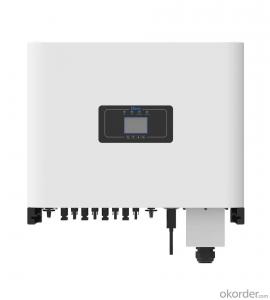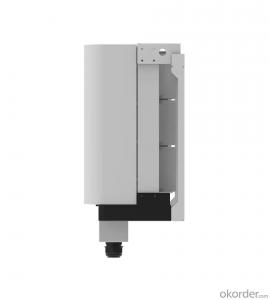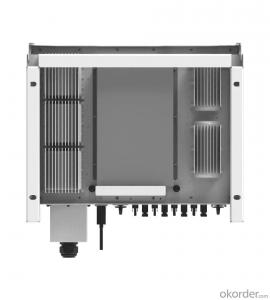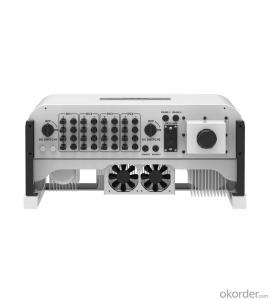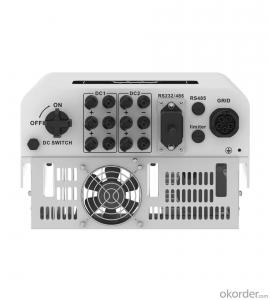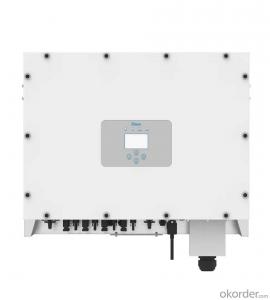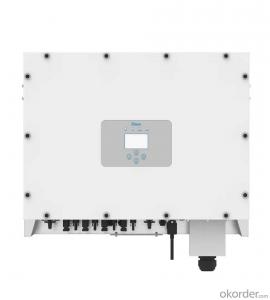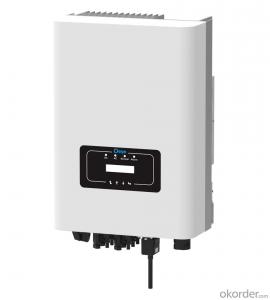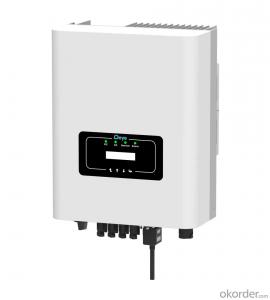220 Volt Solar Inverter Sun-20/25/30k-G02-LV | 20-30kW | Three Phase | 4 MPPT | Low Voltage | 127/220VAC
- Loading Port:
- Ningbo
- Payment Terms:
- TT OR LC
- Min Order Qty:
- 100 pc
- Supply Capability:
- 5000 pc/month
OKorder Service Pledge
OKorder Financial Service
You Might Also Like
Specification
This series inverter is specially designed for 127/220Vac three-phase system, especially suits for South American areas. Equipped with large LCD and buttons, easy to operate and maintenance. The startup voltage of 250V, much lower than 600V of other products, which makes the inverter start up earlier to generate more power with longer working time
127/220Vac and 60Hz, three phase system
Max 4 MPP tracker, Max. efficiency up to 98.7%
Zero export application, VSG application
String intelligent monitoring (optional)
Wide output voltage range
Type II DC/AC SPD
Anti-PID function (Optional)
| Technical Data | |||||
| Model | SUN-20K-G02-LV | SUN-25K-G02-LV | SUN-30K-G02-LV | ||
| Input Side | |||||
| Max. DC Input Power (kW) | 26 | 32.5 | 39 | ||
| Max. DC Input Voltage (V) | 800 | ||||
| Start-up DC Input Voltage (V) | 250 | ||||
| MPPT Operating Range (V) | 200~700 | ||||
| Max. DC Input Current (A) | 40+40 | 40+40+40 | 40+40+40+40 | ||
| Max. Short Circuit Current (A) | 60+60 | 60+60+60 | 60+60+60+60 | ||
| Number of MPPT / Strings per MPPT | 2/3 | 3/3 4/3 | |||
| Output Side | |||||
| Rated Output Power (kW) | 20 | 25 | 30 | ||
| Max. Active Power (kW) | 22 | 27.5 | 33 | ||
| Nominal Output Voltage / Range (V) | 3L/N/PE 127/0.85Un-1.1Un,220 /0.85Un-1.1Un (this may vary with grid standards) | ||||
| Rated Grid Frequency (Hz) | 60 / 50 (Optional) | ||||
| Operating Phase | Three phase | ||||
| Rated AC Grid Output Current (A) | 52.5 | 65.6 | 78.7 | ||
| Max. AC Output Current (A) | 57.8 | 72.2 | 86.6 | ||
| Output Power Factor | 0.8 leading to 0.8 lagging | ||||
| Grid Current THD | <3% | ||||
| DC Injection Current (mA) | <0.5% | ||||
| Grid Frequency Range | 57~62 | ||||
| Efficiency | |||||
| Max. Efficiency | 98.7% | ||||
| Euro Efficiency | 98% | ||||
| MPPT Efficiency | >99% | ||||
| Protection | |||||
| DC Reverse-Polarity Protection | Yes | ||||
| AC Short Circuit Protection | Yes | ||||
| AC Output Overcurrent Protection | Yes | ||||
| Output Overvoltage Protection | Yes | ||||
| Insulation Resistance Protection | Yes | ||||
| Ground Fault Monitoring | Yes | ||||
| Anti-islanding Protection | Yes | ||||
| Temperature Protection | Yes | ||||
| Integrated DC Switch | Yes | ||||
| Remote software upload | Yes | ||||
| Remote change of operating parameters | Yes | ||||
| Surge protection | DC Type II / AC Type II | ||||
| General Data | |||||
| Size (mm) | 362W×577H×215D | 647.5W×537H×303.5D | |||
| Weight (kg) | 25.5 | 44.5 | |||
| Topology | Transformerless | ||||
| Internal Consumption | <1W (Night) | ||||
| Running Temperature | -25~65℃, >45℃ derating | ||||
| Ingress Protection | IP65 | ||||
| Noise Emission (Typical) | <45 dB | ||||
| Cooling Concept | Smart cooling | ||||
| Max. Operating Altitude Without Derating | 2000m | ||||
| Warranty | 5 years | ||||
| Grid Connection Standard | CEI 0-21, VDE-AR-N 4105, NRS 097, IEC 62116, IEC 61727, G99, G98, VDE 0126-1-1, RD 1699, C10-11 | ||||
| Operating Surroundings Humidity | 0-100% | ||||
| Safety EMC / Standard | IEC/EN 61000-6-1/2/3/4, IEC/EN 62109-1, IEC/EN 62109-2 | ||||
| Features | |||||
| DC Connection | MC-4 mateable | ||||
| AC Connection | IP65 rated plug | ||||
| Display | LCD1602 | ||||
| Interface | RS485/RS232/Wifi/LAN | ||||
- Q: Can a solar inverter be used with solar-powered water pumps?
- Yes, a solar inverter can be used with solar-powered water pumps. A solar inverter converts the DC power generated by solar panels into AC power, which is suitable for running various electrical devices, including water pumps. This allows the solar panels to directly power the water pump, enabling it to operate efficiently using renewable energy from the sun.
- Q: Can a solar inverter be used in systems with multiple solar arrays?
- Yes, a solar inverter can be used in systems with multiple solar arrays. In fact, it is common practice to connect multiple solar arrays to a single inverter, especially in larger solar installations. The inverter converts the DC power generated by the solar arrays into AC power that can be used by the electrical grid or consumed directly. By connecting multiple arrays to a single inverter, the overall system efficiency can be maximized, and it allows for easier monitoring and control of the entire solar power system.
- Q: How does a solar inverter handle voltage dips and swells?
- A solar inverter handles voltage dips and swells by constantly monitoring the incoming voltage from the solar panels and adjusting its output accordingly. When there is a dip in the grid voltage, the inverter compensates by injecting additional power into the system, whereas during voltage swells, it reduces its power output to prevent damage. This dynamic response ensures that the inverter maintains a stable and consistent voltage output, protecting both the solar system and the connected appliances.
- Q: What certifications should I look for when choosing a solar inverter?
- When choosing a solar inverter, it is important to look for certifications such as IEC 62109 or UL 1741. These certifications ensure that the inverter meets necessary safety and performance standards. Additionally, certifications like ISO 9001 indicate that the manufacturer follows quality management systems.
- Q: How is the output voltage and frequency of a solar inverter regulated?
- The output voltage and frequency of a solar inverter are regulated through advanced control algorithms and feedback mechanisms. These control algorithms continuously monitor the input power generated by the solar panels and adjust the inverter's output voltage and frequency accordingly. The regulation process involves various components such as voltage regulators, frequency detectors, and digital signal processors that ensure the output voltage and frequency are in sync with the grid or the desired specifications. Additionally, some inverters may also have built-in mechanisms to protect against voltage and frequency fluctuations, ensuring a stable and reliable power supply to connected devices or the grid.
- Q: How does a solar inverter synchronize with the grid?
- A solar inverter synchronizes with the grid by constantly monitoring the grid's frequency and voltage. It adjusts its own output frequency and voltage to match the grid's, ensuring that the solar energy it produces is in sync with the electricity supplied by the grid. This synchronization process allows the solar inverter to safely and efficiently inject solar power into the grid, while also allowing for seamless transition between solar and grid power.
- Q: Can a solar inverter be connected to a generator?
- Yes, a solar inverter can be connected to a generator. This connection allows the solar inverter to work in conjunction with the generator, utilizing both the solar energy and the generator power to meet the electrical requirements of a system.
- Q: Can a solar inverter be used with different types of energy storage systems?
- Yes, a solar inverter can be used with different types of energy storage systems. Solar inverters are designed to convert the direct current (DC) generated by solar panels into alternating current (AC) that can be used to power electrical devices. The AC output from the solar inverter can be connected to various energy storage systems, such as batteries, to store excess energy generated by the solar panels for later use. Therefore, solar inverters are compatible with different types of energy storage systems, allowing for efficient utilization of solar energy.
- Q: How do you choose the right input voltage range for a solar inverter?
- When choosing the right input voltage range for a solar inverter, it is essential to consider the specifications and requirements of the specific solar panels being used. The input voltage range should be compatible with the voltage output of the solar panels to ensure optimal performance and efficiency. Additionally, factors such as the system size, installation location, and local regulations should also be taken into account to determine the appropriate input voltage range for the solar inverter.
- Q: Can a solar inverter be used with a hybrid solar system?
- Yes, a solar inverter can be used with a hybrid solar system. A hybrid solar system combines solar power with other power sources, such as batteries or a backup generator. The solar inverter converts the direct current (DC) electricity generated by the solar panels into alternating current (AC) electricity, which can be used to power appliances and devices. Whether it is a grid-tied, off-grid, or hybrid solar system, a solar inverter is an essential component for converting and utilizing the solar energy effectively.
Send your message to us
220 Volt Solar Inverter Sun-20/25/30k-G02-LV | 20-30kW | Three Phase | 4 MPPT | Low Voltage | 127/220VAC
- Loading Port:
- Ningbo
- Payment Terms:
- TT OR LC
- Min Order Qty:
- 100 pc
- Supply Capability:
- 5000 pc/month
OKorder Service Pledge
OKorder Financial Service
Similar products
Hot products
Hot Searches
Related keywords
